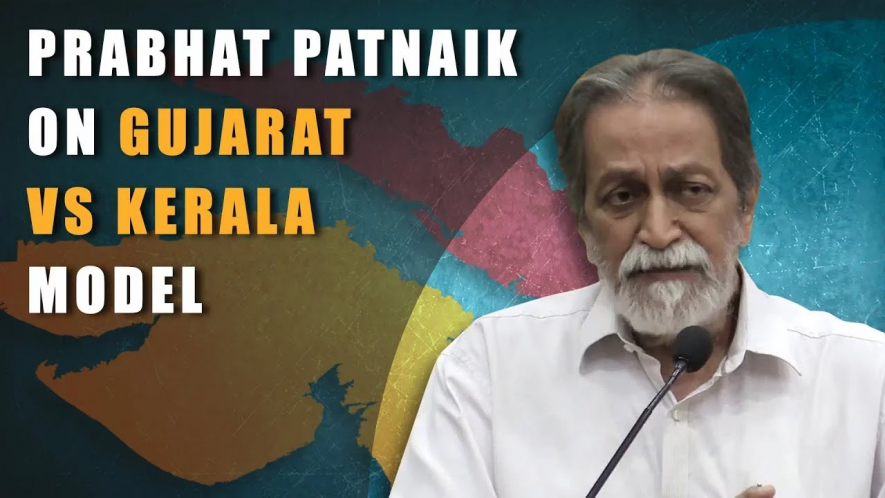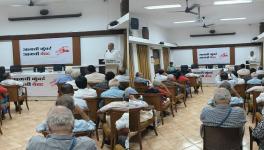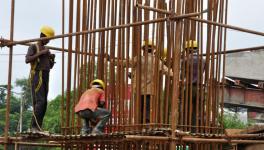Faster Growth With Gujarat Model is a Myth: Prabhat Patnaik

In 2013-14, the Gujarat versus the Kerala model of development used to be a hot topic of discussion. But 2014 onwards, has seen a clear shift to imposing the Gujarat model on the rest of the country. In the last five years, more than even the preceding 10 years, we have seen a much sharper trajectory going towards the Gujarat model that cut workers’ and various benefits and handed over more and more resources to the capital. What do you think the current situation would be if you look at both these models?
PP: This shift you're talking about is very true. It is based on a complete misconception. In fact, if I may say so, even in 2013, or 2014 itself, the discussion was based on a misconception, which is the following. There is a view that the Kerala model produces better results in terms of distribution, welfare and so on, but not in terms of growth. While the Gujarat model produces much better results in terms of growth. Therefore, over a period of time, the means at your disposal which can be potentially handed to the poor, keep increasing faster than in the Kerala model.
Now, this is a misconception. Because I made a calculation comparing the growth rates of Kerala and Gujarat between 2004-05 and 2011-12 over much of which Kerala had a Left Democratic Front (LDF) government and therefore was actually practicing an economic strategy that was distinctly different from that of the United Democratic Front (UDF) and of Gujarat.
You will find that over that period, the per capita real state domestic product of Kerala increased at a rate which was faster than that of the Indian average and which was about the same as that of Gujarat. So, this whole myth that the Gujarat model gives you faster growth is actually nothing else but a myth.
I'm talking about the Kerala model in the sense that the model that the LDF puts into practice, not what happens in the UDF period, though much of it continues but with some kind of deviations. But the Left strategy in Kerala is not only better from the point of view of distribution, but in fact it is as good in terms of the growth rate.
So, what would you actually attribute this to? Because the Gujarat model is very clear – give the capitalists land, force the workers to work at less wages, remove all welfare measures and use that capital for capitalists. So, what explains this?
In fact, you can think in terms of two alternative scenarios. Suppose you have Rs 100 with you in the budget. You can either hand over Rs 100 to the capitalist saying come and invest here. You buy land or give them land or whatever, and they undertake some investment. You have given them a subsidy and so on, that way growth is created.
But what the Kerala model did is, hand over those Rs 100 directly or indirectly as additional purchasing power to the people. By indirectly, I mean, for instance, precisely in the period am talking about, there was a big expansion of public health care, which the UDF had run down. Once people stop going to the private healthcare system and go to the public healthcare system, there is an additional purchasing power in their hands, which they spend. As a result, demand increases, and to meet this demand, there is substantial increase of local small-scale production of all kinds.
During that entire period, no big project was undertaken by any major capitalist group in Kerala. There was some public sector investment, but no big project. Nonetheless, there was a very high rate of growth. So, injection of purchasing power into the hands of the people can have a growth promoting effect, which is no less better in terms of distribution than what you do when you give that purchasing power to the Tatas or somebody else.
UDF also ran down the education system. There was a shift of people putting their children more into private schools, which is a pattern all over India except, perhaps, marginally with the Delhi government which seems to have also invested in education. Now that the LDF has come back, they've really put a lot of investments in the school system….
Absolutely. In fact, I think in Kerala, the fact that the LDF government put in more money into education and into healthcare is something that was really appreciated by society at large. As a matter of fact, subsequently when there was some effort at running down expenses in hospitals, there were massive protests, including by doctors. So, the point is that and this is very similar to, for instance, in England when Margaret Thatcher tried to demolish the NHS (National Health System), there was a massive protest, including from the medical profession and the same medical profession that had originally been opposed to introduction of NHS. So, I think at a certain point, they begin to see that it is socially beneficial. And I think the same thing in Kerala has now become common belief in sphere of education as well as health care.
Let's take the reverse. If you do not do these -- run down the health as well as public education system -- what are the consequences in society both in terms of growth and impact on the people?
You will have a combination of two things. There would be some exclusion, naturally many people would not be able to afford and therefore would drop out. But even more important is that those who really would be sending their children to private healthcare or education system, would do so by reducing their expenditures in other avenues, including on food. In fact, one of the reasons, not just in Kerala but everywhere in India, why hunger has increased is precisely the privatisation of these essential services. So, you find that purchasing power, which could have been diverted either to allaying hunger or buying local goods, now goes into the pockets of private providers of education or healthcare. Therefore, this actually has a growth restraining effect.
Also, for example, if there is any disease that can be considered serious, then even the lower middle class or the section which is not exactly poor descends into absolute poverty as a consequence of sudden loss of income or a huge expenditure.
Absolutely. As a matter of fact, that is one of the main reasons for peasant distress over large parts of India. In Kerala, again during that period, we brought in a Bill in order to provide debt relief. In fact, we set up a debt relief commissioner. I was a part of the government. And one of the issues raised in the Assembly was that look a lot of the debt is incurred not because of agricultural operations, but because of health expenditures and so on, so should the state be taking over the responsibility for the debt incurred for non-agricultural purposes through an agricultural debt relief commission? To which the answer was that when an agriculturist is concerned, his economy is the total economy. You don't really have a separation of agricultural accounts from non-agricultural accounts. So, you are absolutely right that the increase in expenditures in these ways is a very important reason for distress and debt.
So you do think that the farmers’ distress, part of this reason is actually things like health?
Absolutely. In fact, this is something which is true all over India. Newspapers are full of stories like somebody's child suddenly gets a serious illness, say, in the neighborhood of Delhi. They bring the child to Max Hospital where the child is admitted. Fairly soon they have to pay the bill, so they go and sell the plot of land or take a debt, mortgage the land. That's just enough to pay the past bills. Then the child is released despite being sick and dies. So, the parents have lost both -- the land as well as the child. Such heart-rending stories are there and I think privatisation of essential services is one of the most distress-causing factors in the current Indian economy.
A lot of the middle class has a fascination for neoliberal economy because the section has benefited and they don't want to go to government hospitals or send their children to government schools. You also have private hospitals providing government servants with private health care.
I think there is a chicken and egg problem here. If you have public expenditure being withdrawn from public health care, from public education and so on, in that case, it is automatic that you actually run down these facilities. In which case, naturally the middle class goes there. But the middle class won’t be averse to a good public health care or education system. The same is the case of universities now. If you actually do not provide funds to public universities, then naturally you want to privatise the education. So, it's a very deliberate action. The thing about the Kerala model is that it did not go down that path.
Having gone down that path, both in the Manmohan Singh era and even more so under Modi, expectations that there would be growth of industry, jobs and so on, have not been fulfilled. If we take the other part, growth would be generated but distribution is poor, but here growth is actually not being generated.
Yes. Absolutely. And I think behind it are also developments in the world economy. Basically, post-2008, there has been a slowing down of growth rate in the world economy. Initially, countries like China and India appeared to be not suffering from that slowdown, but that is no longer the case. Even the Chinese economy, which has been so dynamic all these years in terms of growth rates, has slowed down. So has India. What is more in the case of India is even the period of high growth was one in which employment was not being generated in any noticeable way. In the period of slow down, employment generation has slowed down further. And on top of that, when you add the effects of demonetisation and GST and so on, which really dealt huge blows to the small production sector, informal sector or the petty production sector, you find that really we have a huge employment crisis in our hands.
Take the ‘Gujarat model’ where you give incentives to big capital. It does not take into account what happens to the informal sector, which is the mainstay of actual employment in the country. Do you think demonetisation and GST were the two major blows to the informal sector dealt by the Modi government?
Absolutely. It is a huge blow to the informal sector. The indebtedness which a lot of peasantry got into at that time, because demonetisation occurred just around the time that they were going to buy their inputs and so on they took it that indebtedness, remains like an albatross around the peasants necks all these years.
But what is more, I think, now the Gujarat model even in terms of successfully attracting big ticket investment is not one that has much of a future because I think big ticket investment itself is beginning to slow down/ So, from that point of view, that is an avenue which does not have much of a future.
So, unless we stimulate demand, this is not going to happen, and stimulating demand means more purchasing power in the hands of the people and more state investment. Both of these are barred under neo- liberal policies of either P Chidambaram or Narendra Modi.
I think that is absolutely right. I think it's quite interesting. One of the things in Kerala which is worth seeing is how does a state government have some leeway even within a broadly neoliberal paradigm to actually enlarge its expenditures. In that period (2014-05 to 2011-12), the government did enlarge its expenditure. I know because when we started, we developed a concept of free plan outlay… Our free plan outlay, when we started, was about Rs 300 crore, and when we ended in the fifth year, it was over Rs 2,000 crore. So. we actually raised resources. But the point is that now that kind of thing neo-liberalism is trying to stop, because one of the things GST does, is to remove the state government's capacity to raise taxes as they like.
Get the latest reports & analysis with people's perspective on Protests, movements & deep analytical videos, discussions of the current affairs in your Telegram app. Subscribe to NewsClick's Telegram channel & get Real-Time updates on stories, as they get published on our website.
























